While in Ecuador, I learn a new word in Spanish: nudillos. It means “knuckles,” and that’s exactly what a sloth is extending us—all three knuckles—as we hike along a jungle-lined trail from Middle Jondachi River. Most people come to Ecuador to see the Galapagos. For good reason. It’s one of the most pristine marine eco-systems on the planet. But from climbing and skiing volcanos to bird watching in the Amazon Basin, there’s plenty more to do as well. Our trip just so happened to focus on paddling. A lot of it. Seven rivers in seven days, in fact, thanks to the team at Small World Adventures, whose founders have been exploring the region’s rivers for nearly 30 years.
After arriving in Quito and overnighting at the Hotel San Juan De Pembo, we’re picked up in the morning by company co-owner Darcy Gaechter. You might know her from her book, Amazon Woman, detailing her 148-day journey in 2013 to become the first woman to kayak the entire Amazon River.
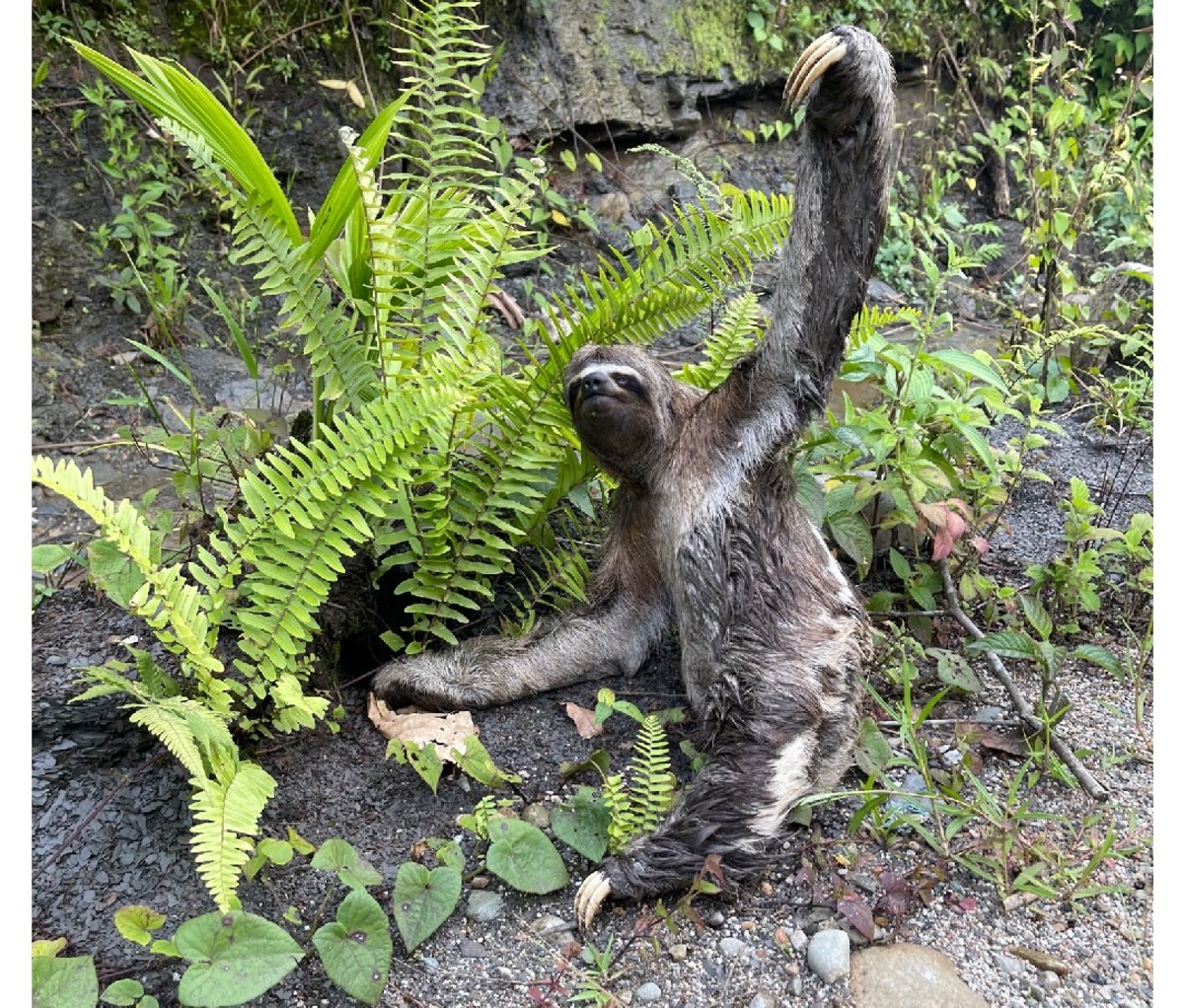
On the drive, our guides outline what’s in store—and thankfully, this expedition won’t be as arduous as that. We’ll be sleeping on cushy hotel beds, dining on homecooked fare (yes, cuy, or guinea pig might be on the menu), and shuttled around to different rivers every day, which we’ll paddle under the watchful eye of certified guides, including Gaechter; her business partner, Don Beveridge, who joined her on the Amazon; and a cadre of the top kayakers in Ecuador. They’ll decide what to paddle each morning based on rainfall reports.
Formulating a Game Plan
First, we climb to the top of 11,394-foot-high Papallacta Pass, the very same spot crossed by conquistadores Gonzalo Pizarro and Francisco de Orellana in 1541 in an ill-fated expedition to find the Land of Cinnamon. (Eventually, Orellana would go on to complete the first known navigation of the entire length of the Amazon, initially named “Rio de Orellana.”)
From there, we descend into the Amazon Basin, or El Oriente, passing the town of Papallacta at 10,827 feet, the highest town in the country and one of the highest towns accessible by car on Earth. Finally, it’s down to the town of Borja, situated at 5,200 feet along the Rio Quijos, our home for the next three rivers. The river’s water is funneled down from the 18,875-foot Antisana volcano, nearly 13,000 vertical feet above.
We unload our gear pull at the Hotel Luxor before walking over to the boat shed, or bodega, to pick out our kayaks from a well-appointed quiver (“The world’s largest selection in Ecuador,” Don says). We’ll come back each night in a vain attempt to dry our gear, and pack it all up wet again each morning.
We also meet our Ecuadorian guides, Vladimir (“Blaster”), Andres, Brian, Jair, and Byron. With Don paddling here since 1993 and Darcy since 2005, they’ve both done wonders in growing the local paddling community. They, along with company co-founder Larry Vermeeren, are the de facto Godfathers of kayaking in Ecuador, even writing its guidebook The Kayaker’s Guide to Ecuador. Now in its third edition, the definitive book details the 77 different runs they’ve paddled.
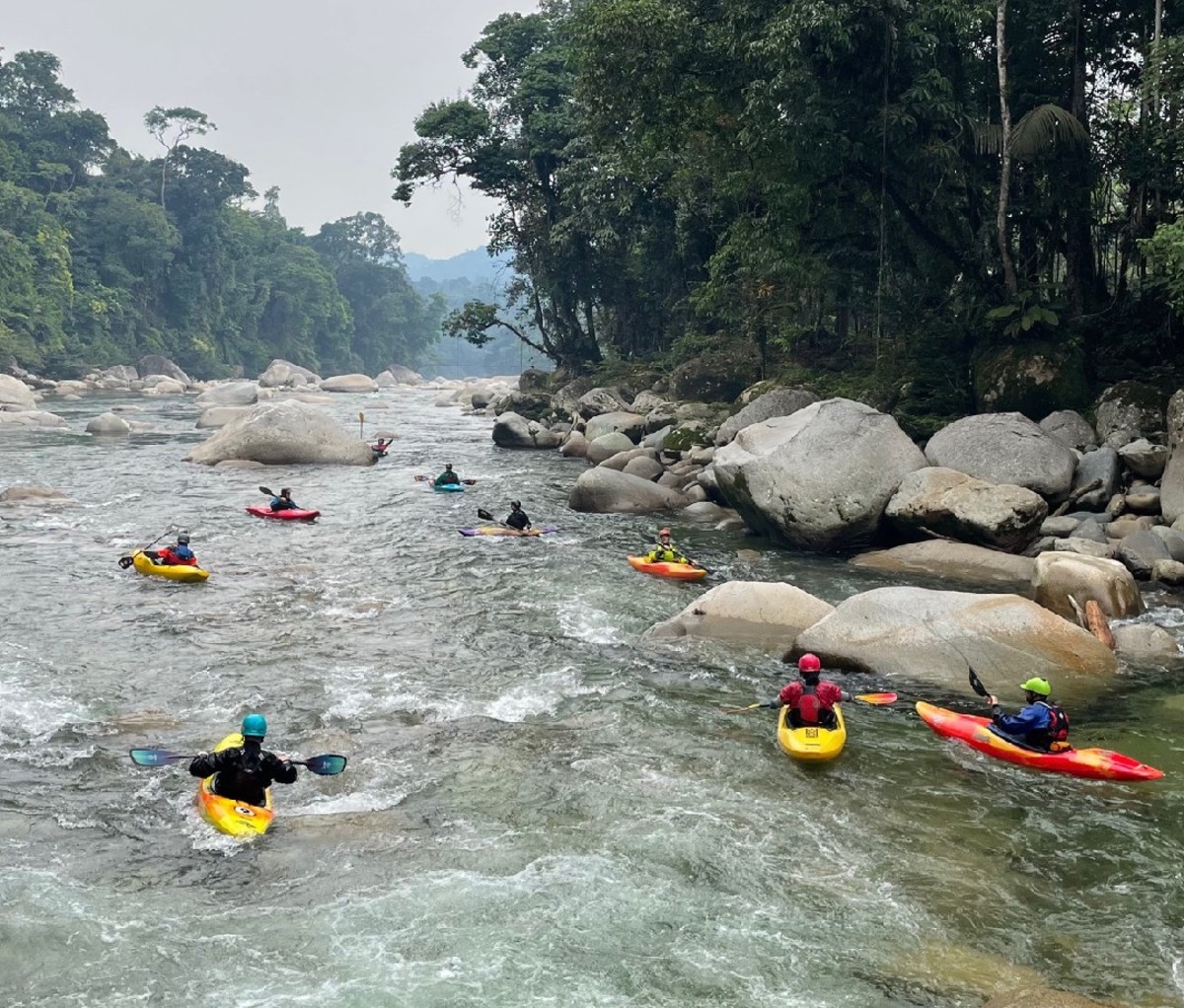
The Seven-Foot Launch Test
On day one, we put on the Oyacachi, launching off a seven-foot-high drop just three strokes into the run. Welcome to kayaking in Ecuador, I muse, after we regroup in the eddy below. With one guide in front showing us the line, one in the middle (so our runs don’t turn into that kids’ game of “Telephone”), and a third running sweep, we make our way down countless horizon lines, Don ushering us through like a mother duckling. It’s good he does. From the low vantage of a kayak, every rapid is a distinct horizon line, which would have taken us days to scout and run on our own.
Later that day, we dump into the Rio Quijos—confronting such Class IVs as Chuchqui (which means “hangover”) and Curvas Peligrosas, which promptly knocks me over. But at least I fare better than Jim, who rolls then gets pushed in the wrong channel, requiring a boat hike. Scour marks 40 feet high up the canyon’s basalt walls show how high and powerful the water can get come rainy season.
Soon we hit the take-out, hiking our kayaks up to our driver, Lobo, and a cooler of Pilsner beers. Back at the hotel, we luxuriate in a hot tub and enjoy a home-cooked dinner of braised chicken with fried plantains—before notching a sheet for an honor system bar (20-ounce Pilsners and tequila shots: $2!) and sharing stories of the day.
A Wet Slap in the Face
On our second day, we hit the Quijos’s El Chaco section, battling such rapids as Slap in the Face, pulsating El Toro and Gringos Revueltos (“Scrambled Foreigners”), which leaves two of our group swimming. We continue paddling through yesterday’s Bombon section, faring better this time in Curvas Peligrosas, and continue down into the Lower Quijos, marking a tiring, 17-mile day.
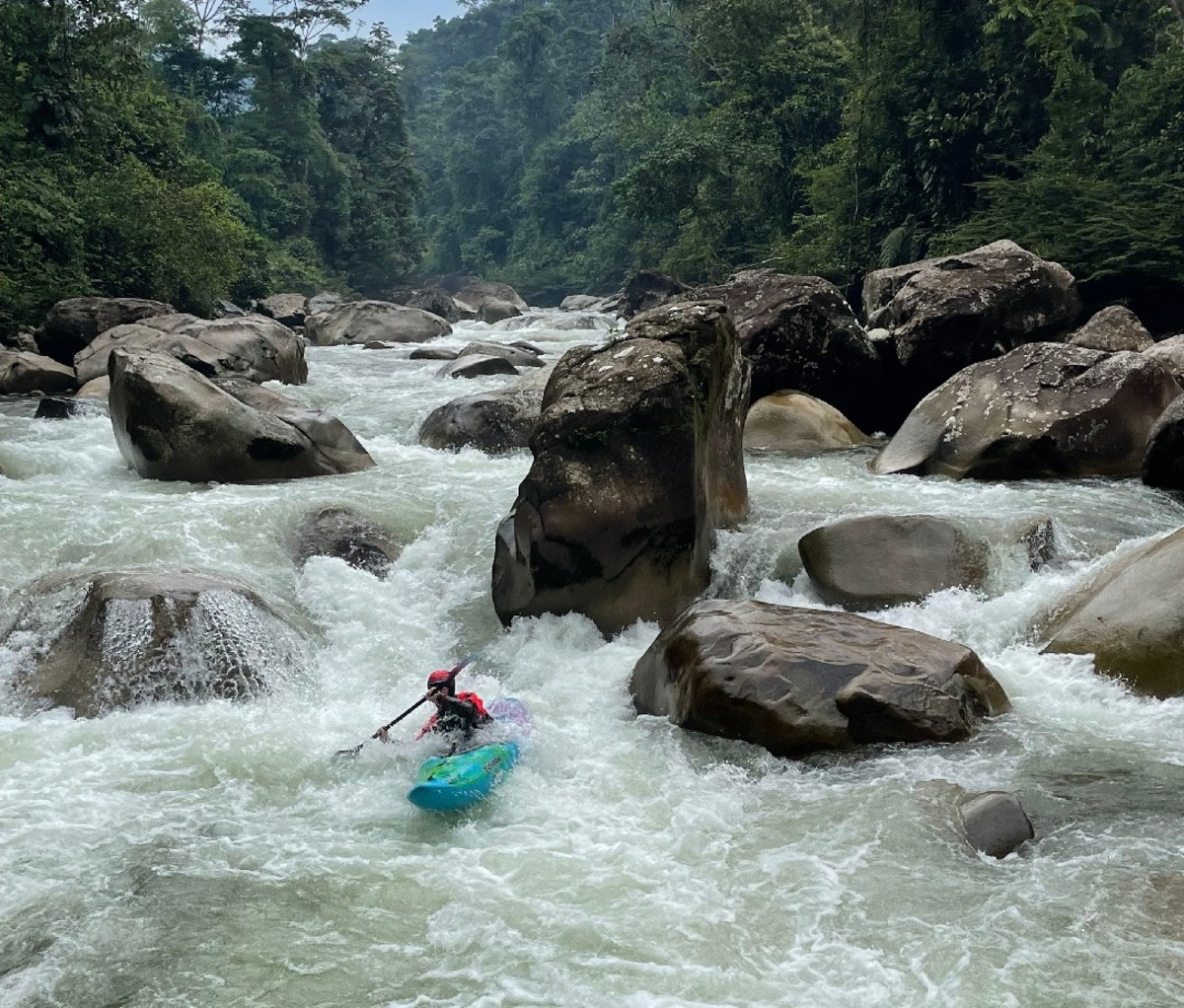
We take out about 10 miles above one of the biggest geologic anomalies on the planet: the recent disappearance of 490-foot San Rafael Falls, the tallest and most visited waterfall in Ecuador. Yep, it completely disappeared in 2020, like someone making off with Niagara in the middle of the night. Puff, gone. Fingers point to the $2.6 billion Coca-Codo-Sinclair hydro dam built 10 miles upstream—that came on line in 2016—as the culprit. Capable of producing 1,500 megawatts, or 8.8 billion kilowatt-hours per annum, and supplying 35 percent of Ecuador’s overall consumption, one theory suggests it’s taken sediment out of the river, causing the river to take more out downstream.
Combined with a new sinkhole appearing near the waterfall’s lip, the river scoured a new sieve, de-watering the country’s most visited waterfall. (An oil road that used to be level with the river is now 400 feet higher—the river absorbing the gradient previously provided by the falls.)
On our third day, it rains cats and dogs. Wait, that is a dog—barking at the dawn roosters crowing away. Still, it’s misting out and we’re up early and in the bus, massaging sore shoulders and backs. Don outlines the day’s plan and we load up and drive over 8,000-foot Guacamayo Pass, splitting two national parks, before descending to 1,800 feet in the Amazon Basin town of Tena. Today’s run is the crown jewel, Middle Jondachi—a jungle-lined, pool-drop fun fest that instantly rises to the top of everyone’s list for the week. “It’s at the perfect level,” Don says, advising us to wear soccer socks, if we have them (which I don’t), for potential bugs at the takeout. Next time.
A Fish-Eating Spider as Big as a Baseball Mitt
The horizon lines are nonstop as we follow the guides “blue angel” style, pulling into an eddy, looking over your shoulder to watch where the front person goes, ] then peeling out so the next paddler can take your spot. Everyone has some trouble somewhere, with two more swims tallied for the group in such rapids as Gringo Tostadas (I’m sensing a theme) and Guy (Guinea Pig) Roulette. As the river tapers off toward the end—after 60 Class IV rapids in 12 miles—waterfalls cascade in from the banks. In one eddy Mike spies a spider as big as a baseball mitt, which Don says actually eats fish, before it disappears into the water below us. Definitely don’t want to roll here…
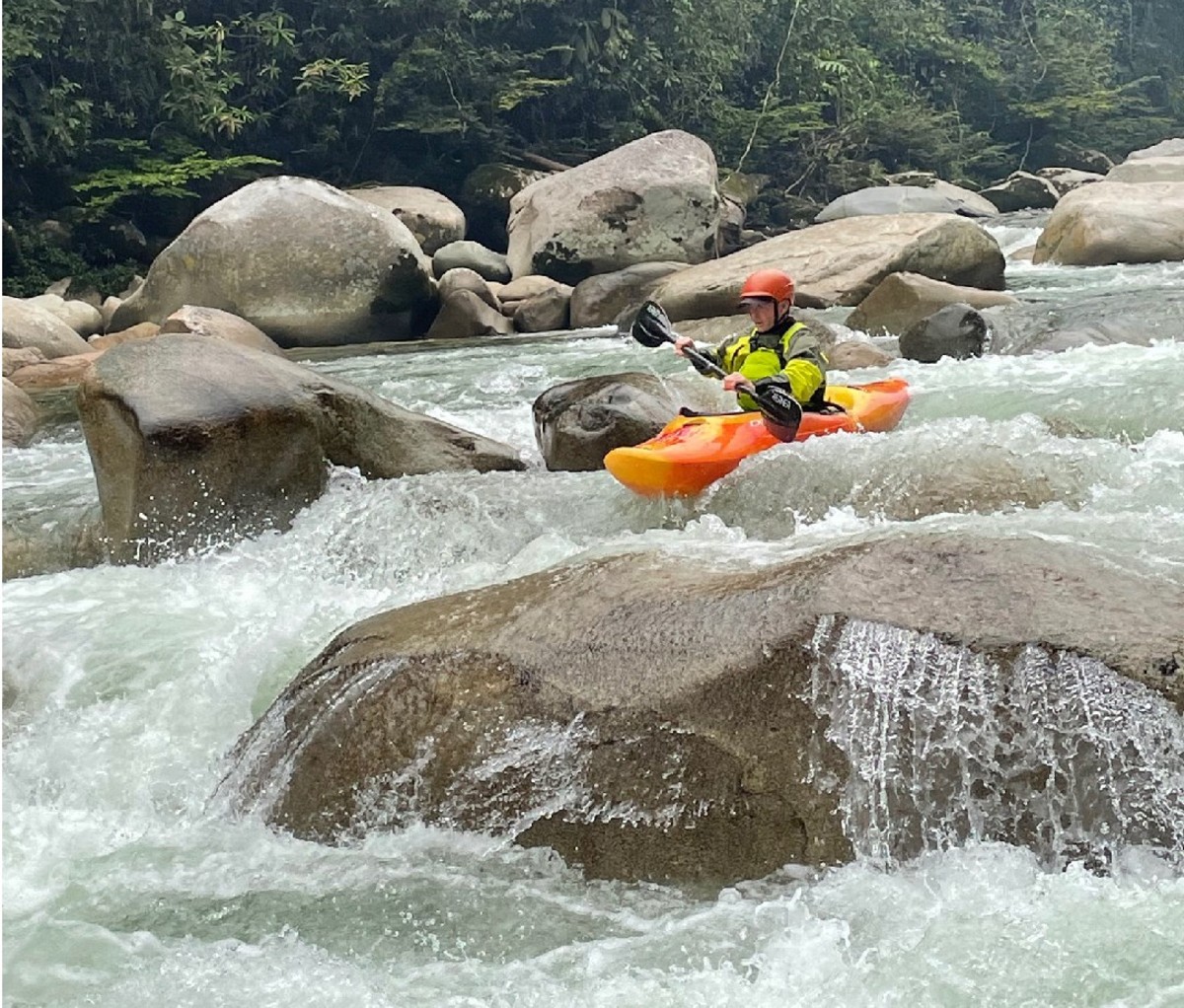
After a short hike up from the takeout, we spy our knuckles friend, a three-toed sloth giving us the slooowest three-knuckle fist pump in the books—congratulating us on our run. Overhead, Dr. Seuss-like bird nests of the “oro pendula” droop from a tree.
Up top, we load the kayaks onto the bus and crank the tunes as Lobo drives us to the Hotel Yutzos in Tena, right at the confluence of the Pano and Tena rivers. Tonight’s “debriefing” comes at an outdoor bar, in between shouts for the Ecuador/Peru soccer game, which ends in a tie. The plan: Tomorrow we’ll hit the magical Rio Piatua, an hour south, if water levels hold. Don hopes something else holds as well. Glancing up, he sees five bats wriggling around on a tree branch just a few feet above his head.
Day four has us sharing coffee with treetop monkeys next to the hotel’s porch. The rainfall is dynamic here. Going with Darcy instead of Don today, and without any word from their colleague on the state of the river, we head to the Piatua anyway with fingers crossed on the flows.
Change for $1,000—in Singles
A swinging bridge to nowhere, put there by dam builders before the project stalled, marks our put-in. Blindly following her Amazon-honed line drop after drop, we monkey-see-monkey-do Darcy down to the junction with the Piatua Blanca, beneath rich green banks lined with the red flowers of Yutzos trees. There are way too many rapids to distinguish. Eventually, we reach a hidden take-out on the right—there would be no way to find it on our own—and carry our kayaks up a steep hill to Lobo and the bus. On the way back to Tena, we stop at a roadside store and buy fresh cacao and wayusa, Ecuador’s natural version of Red Bull. We pay with an assortment of small bills, mainly ones.
Ecuador replaced its sucre currency with the U.S. dollar in 2000 after using it since 1884. Back on the bus, where Lobo passes a single-bed truck with a giant cow standing in it, Darcy says their former partner Larry once went into a bank to exchange $1,000 U.S. dollars and came out with two huge duffel bags of sucres.
Day five has us on a nine-mile section of the Rio Anzu, similar in rock-drop character to the Piatua, only with more water. It’s our longest hike yet, shouldering our boats to get to the put-in, but we’re rewarded with yet another idyllic waterway—emerald green water, coursing its way through a maze of rounded boulders. A wall of orchids cling to the cliff on the right. It’s a step up from the Class III-IV Piatua, and a step down from the Jondachi. In other words, right in our wheelhouse yet again.
The crux in Anzu Falls is a maelstrom of boulders channeling water through multiple spouts. We take a line down the far right, per Darcy, sliding over a series of rocks into a “lagoon” to scout. Eric misses the move and paddles over the next brink blind, causing Jair to give chase. He makes it to a pool far below—okay, but not without redlining his adrenal glands. Another paddler in our group swims, and another nails a combat roll to avoid it.
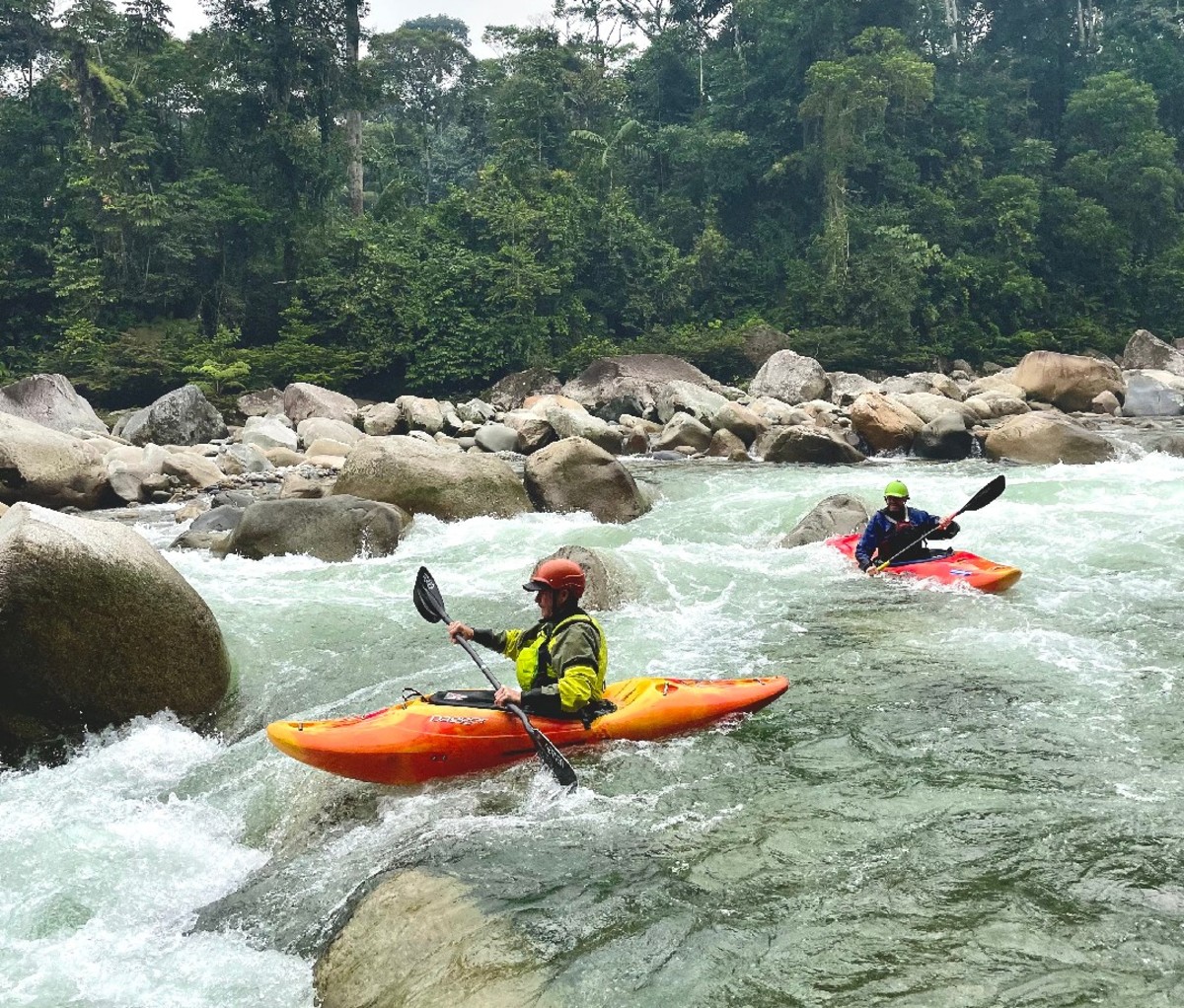
Farther down, we see a rodent—a guatusa—swimming across the river using its snout for a snorkel, popping up, surprised, in the middle of our kayaks. A whirlpool sucks him back under and he disappears. Just when we think he might drown, he pops up again, barely making it into an eddy before the current careens off another ledge. We’re not the only ones struggling in the river. “I was going to help him, but they bite pretty hard,” says Andre as we paddle on toward the next drop.
Soon the takeout appears on river left, where Lobo is waiting. There’s no hike out this time, thank God. Just a cooler of cold beers. That night we rehash stories of our past three days in the Tena region, a general consensus ranking them in order: Jondachi, Anzu, then Piatua. But that’s not fair to Piatua, because it’s one of the best rivers we’ve ever paddled.
One Nasty Bump on the Head
After a breakfast of rice, beans, eggs, and plenty of hot sauce, day six sees us hike from a house along the road down to the Cosanga. The level is low but good for its continual Class IV. “It’s a creek-y river,” Don explains, as if that sums it all up. Their guidebook calls it one of the prettiest Class IV rivers in all of Ecuador, but we find that hard to believe after what we’ve paddled already.
Rapids such as Starts with a Bang, Go Left or Portage, Menage a Rodeo, and Chibola (“Bump on the Head”) come as quickly as our braces. The rain comes as well, falling down in sheets. It’s easy to see how quickly rivers here can rise. Our bump in the head comes at a rapid called Random Acts when Jim tips over and hits a rock. When he rolls up, blood pours down his cheek. Fortunately, there’s a swinging bridge just downstream. Darcy patches him up and calls Lobo to meet him and Jair after they hike out a steep trail up to the road. They leave their kayaks stashed high on the bank; Don and Andres will hike back down and paddle them out later this afternoon. The end result at the hospital: five stitches.

The rest of us paddle on, passing tall, Kauai-esque waterfalls freefalling from 1,000 feet above, the ribbons of white contrasting the primordial green. Soon we spill into the Quijos, halfway down its Baeza-to-Borja section. The water is bigger and more powerful, with a couple rapids requiring moves to miss holes. Soon we see Lobo on river left—with a freshly stitched-up Jim.
On the drive, Darcy opens up about everything from rivers to relationships. Writing her book was hard, she says, adding the project took six and a half years. “I thought I’d do it in eight months, but it took a lot longer,” she says. “It was like running a rapid: challenging, but fun trying to figure it out. I’m more proud of having written the book than kayaking the Amazon.”
Then she moves onto Don and the third member of their party, David “Midge” Midgley, whose idea it was for the expedition. “I was very determined not to side with Don in any arguments we had, which sometimes made it extra hard on him,” she says. “Our relationship was a little bit damaged right after, but now it’s way better. If we can survive the Amazon, we can survive anything.”
I feel the same way about the markedly un-sloth-like week we just had. Back at the Hotel Luxor, we drink beers and enjoy $30 massages to coax our upper bodies into one more day of paddling after six straight.
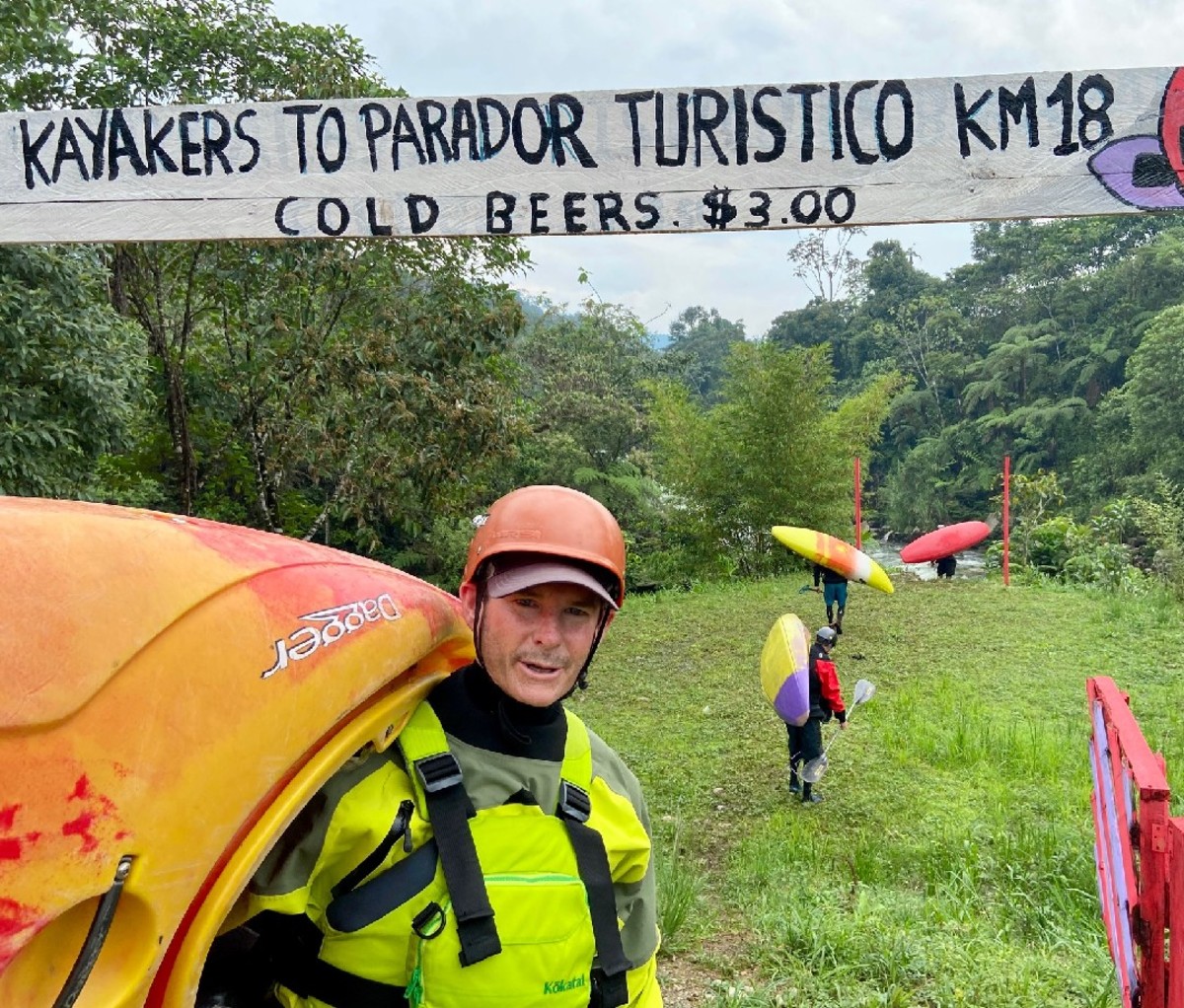
Our last day in Ecuador, we hit the Oyacachi and Quijos again, this time Curvas Peligrosas getting the upper hand despite our experience with it already. Four of us get knocked over in its main hole, which is difficult to miss, while both Ben and Jason swim out of it. Darcy counts six seconds of downtime for Ben, a stage four colon cancer survivor, who’s dragged his friends here for this bucket-list trip. Even Andres gets knocked over. It’s as if it’s saying “Hasta luego, gringos,” before we leave. Something to remember it by.
Back at the hotel, we feebly try and dry out our equipment while eating empanadas and packing up. It doesn’t work and our gear goes into our luggage wet. Lobo shuttles us back to Quito for our late-night flight home.
Don, whose record here is 123 straight days of paddling (148 on the Amazon with Darcy) tags along to shop and pick up the next group in the morning to head right back out.
After all, they only have two weeks left in the season.
from Men's Journal https://ift.tt/fxmAhsq





No comments:
Post a Comment